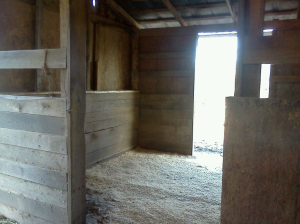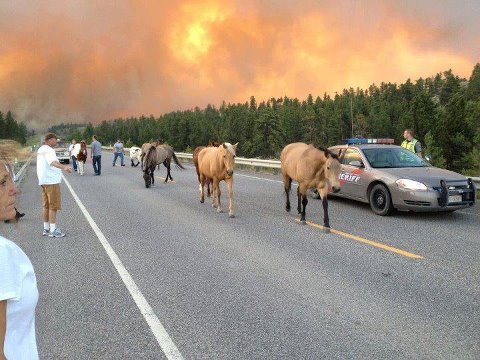You might think that cleaning a horse’s stall is a no brainer. Scoop up the old stuff, dump it, and put in some fresh bedding. That basically covers it, but there are ways to make it easier, more efficient, and better for your horse as well.
First, let’s take a look at the basic layout of your stall. Do you have mats covering the floor? Most people do. If you have a dirt floor, mats are optional, but if your floor is cement, then mats become very important to protect the horse’s feet and legs.
Let’s start with the dirt floor stall. If it isn’t even, you’ll need to add some stone dust to fill any holes in the floor. Be sure to pat it down well before putting a mat over it, or youll just have to do it again. Lay your mats side by side with no overlaps. Be sure to place the mats so they all go in the same direction. Mats laid at angles or in a zig zag pattern, or mats that overlap at the edges will make it hard to clean a stall.
Once you have the mats down, it’s time to choose your bedding. There are many different types, and several factors to consider when choosing which one to use. Cost is usually a major decision maker. There are absorbent synthetic beddings that are resiliant and comfortable under the horse’s feet, but most of them are fairly pricey. If you can afford one of these, either the pelleted type or a recycled paper type, you will probably find yourself with a beautiful stall, but you will be spending a lot of money on bedding.
The most popular type of bedding is kiln dried hardwood. This comes in several grades, from large wood chips which are not very absorbent to finely ground sawdust.
The wood chips are less absorbent, but cheaper. When used in a stall, it usually takes several days for it to be ground by the horse’s feet to a comfortable texture. New wood chips are difficult to clean because they are larger and not absorbent. They do not easily fall through the tines of your pitchfork, making it more difficult to sift the clean bedding from the dirty.
On the other end of the spectrum is the finely textured sawdust. This is usually dust free, and makes a nice cushion for your horse. In order to be effective, you will have to use a lot of bedding in each stall. Sawdust must be fairly deep in order to be effective. It is very absorbent, so wet spots tend to stay put and not spread around the stall. Manure is easily sifted, but you will need a special fine tined fork to effectively pick up the smaller pieces. The wet spots are a bit harder to eliminate as the sawdust tends to fall through the tines of the pitchfork. This can be both frustrating and time consuming, and you will end up with a stall that still has tiny pieces of wet or soiled bedding in it.
The best balance of effectiveness and economy that I have found is the mid-range wood shavings. These shavings are absorbent and fairly inexpensive, and work well to absorb and cushion. They are easy to work with and require no special equipment.
The next question is how muuch to use. If you can afford to keep several inches of bedding in a stall and replace it all every day, you are probably not cleaning your stalls yourself. At that level, you probably have hired someone to clean for you and don’t need this article in the first place.
If, however, you are concerned with cost, you will be relieved to know that it is not necessary to use several bags in each stall every day. In fact, putting in too much bedding or overbedding, can make it more difficult to clean. If the bedding is too heavy for your pitchfork, you will not be able to dig all the way down to the floor to get up the bottom level of soiled bedding.
Using too little bedding will not harm your horse. Horses sleep on the ground with no padding all the time. They do not need layers of padding unless there is a health problem or medical condition that requires special handling. If your horse has a problem with his feet or legs, you may want to consider a soft, cushiony layer of bedding, otherwise the primary reason for using it is to absorb urine and make it easier to keep the stall floor dry.
A fine layer of bedding is better than none at all, especially if you have a dirt floor with no mats. It will absorb and can be easily raked up and disposed of.
The best is a moderate amount, enough to feel soft under your feet, but not so much that it fills your shoes if you walk into the stall. This usually means starting with one or two bags of bedding, then sifting it and adding a little at a time as needed.
When cleaning, try to work in one direction, the same direction that the mats are laid. I find that a basket type pitchfork is most efficient, but some prefer a standard style flat fork. The basket forks contain a lot more bedding and lift a lot more manure for quicker removal. I find that the basket type fork cuts my stall cleaning time by about a third.
When you pick up a fork full of soiled bedding or manure, give it a little bounce so that any clean bedding you might have picked up will fall through the tines and can remain in the stall. There is no need to take out every bit of bedding every day. Only the wet or soiled bedding needs to be removed.
Once you have cleaned out the stall, it is time to add more bedding. There may be days when none is needed, while other days the horse may have kicked around the entire contents of his stall. Using the pitchfork, spread fresh bedding as needed to maintain the moderate amount of bedding you had to start with.
One other type of bedding deserves mention, and that is straw. This does need to be completely removed each day and replaced with plenty of fresh straw. A flat pitchfork works best for this as it needs to be impaled on the pitchfork rather than sifted. This method is considered passe by most modern horse owners, but it is still available and not very expensive in most areas.
One more word of caution, and that is if you have a heavy load in your pitchfork, remember to lift with your legs and not your back!



